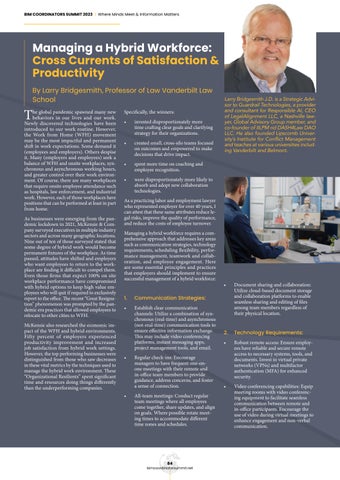BIM COORDINATORS SUMMIT 2023 | Where Minds Meet & Information Matters
Managing a Hybrid Workforce: Cross Currents of Satisfaction & Productivity
T
By Larry Bridgesmith, Professor of Law Vanderbilt Law School
he global pandemic spawned many new behaviors in our lives and our work. Newly discovered technologies have been introduced to our work routine. However, the Work from Home (WFH) movement may be the most impactful and permanent shift in work expectations. Some demand it (employees and employers). Others despise it. Many (employers and employees) seek a balance of WFH and onsite workplaces, synchronous and asynchronous working hours, and greater control over their work environment. Of course, there are many workplaces that require onsite employee attendance such as hospitals, law enforcement, and industrial work. However, each of those workplaces have positions that can be performed at least in part from home. As businesses were emerging from the pandemic lockdown in 2021, McKensie & Company surveyed executives in multiple industry sectors and across many geographic locations. Nine out of ten of those surveyed stated that some degree of hybrid work would become permanent fixtures of the workplace. As time passed, attitudes have shifted and employers who want employees to return to the workplace are finding it difficult to compel them. Even those firms that expect 100% on site workplace performance have compromised with hybrid options to keep high value employees who will quit if required to exclusively report to the office. The recent “Great Resignation” phenomenon was prompted by the pandemic era practices that allowed employees to relocate to other cities to WFH. McKensie also researched the economic impact of the WFH and hybrid environments. Fifty percent of employers experienced productivity improvement and increased job satisfaction from hybrid work settings. However, the top performing businesses were distinguished from those who saw decreases in these vital metrics by the techniques used to manage the hybrid work environment. These “Organizational Resilients” spent significant time and resources doing things differently than the underperforming companies.
Specifically, the winners: •
invested disproportionately more time crafting clear goals and clarifying strategy for their organizations.
•
created small, cross-silo teams focused on outcomes and empowered to make decisions that drive impact.
•
spent more time on coaching and employee recognition.
•
were disproportionately more likely to absorb and adopt new collaboration technologies.
Larry Bridgesmith J.D. is a Strategic Advisor to Guardrail Technologies, a provider and consultant for Responsible AI, CEO of LegalAlignment LLC, a Nashville lawyer, Global Advisory Group member, and co-founder of IILPM nd DASH4Law DAO LLC. He also founded Lipscomb University’s Institute for Conflict Management and teaches at various universities including Vanderbilt and Belmont.
As a practicing labor and employment lawyer who represented employer for over 40 years, I can attest that these same attributes reduce legal risks, improve the quality of performance, and reduce the costs of employee turnover. Managing a hybrid workforce requires a comprehensive approach that addresses key areas such as communication strategies, technology requirements, scheduling flexibility, performance management, teamwork and collaboration, and employee engagement. Here are some essential principles and practices that employers should implement to ensure successful management of a hybrid workforce: 1.
Communication Strategies:
•
Establish clear communication channels: Utilize a combination of synchronous (real-time) and asynchronous (not-real-time) communication tools to ensure effective information exchange. This may include video conferencing platforms, instant messaging apps, project management tools, and email.
•
•
Regular check-ins: Encourage managers to have frequent one-onone meetings with their remote and in-office team members to provide guidance, address concerns, and foster a sense of connection. All-team meetings: Conduct regular team meetings where all employees come together, share updates, and align on goals. Where possible rotate meeting times to accommodate different time zones and schedules.
84
bimcoordinatorsummit.net
•
Document sharing and collaboration: Utilize cloud-based document storage and collaboration platforms to enable seamless sharing and editing of files among team members regardless of their physical location.
2.
Technology Requirements:
•
Robust remote access: Ensure employees have reliable and secure remote access to necessary systems, tools, and documents. Invest in virtual private networks (VPNs) and multifactor authentication (MFA) for enhanced security.
•
Video conferencing capabilities: Equip meeting rooms with video conferencing equipment to facilitate seamless communication between remote and in-office participants. Encourage the use of video during virtual meetings to enhance engagement and non-verbal communication.
